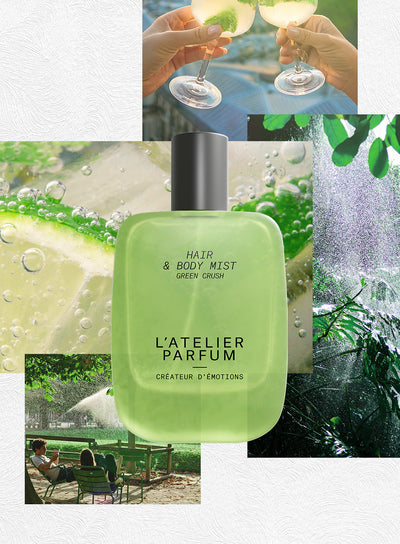- Ingrédients, Tubéreuse
- L'Atelier Parfum
Tuberose: a Noble and Bold scent

What is Tuberose?
Tuberose (Polianthes tuberosa) is a flowering plant native to Mexico, belonging to the Agavaceae family. Its name comes from the Latin tuberosa, meaning "tuberous" or "tube-shaped," referring to its fleshy roots that form underground tubers. Although often referred to as a flower, tuberose is actually a flowering stem, bearing small flowers arranged at its top.
The Origins of Tuberose
Tuberose has deep roots in Mexican history, where it was cultivated by the Aztecs long before the arrival of Europeans. They used it in rituals and scented wreaths. Introduced to Europe in the 16th century by the Spanish, it quickly conquered the world of perfumery.
Even today, tuberose remains a precious raw material, known for its opulent floral fragrance. Used primarily as a heart or base note, it brings a carnal and hypnotic dimension to perfume compositions. Its nocturnal character makes it a preferred note for elegant and sophisticated perfumes, perfect for evenings and special occasions.
Growing Tuberose
Growing tuberose is a delicate art that requires patience and precision. Although native to Mexico, it is now cultivated in warmer regions such as India, Hawaii, China, parts of Africa, and South America.
The tubers are planted in spring in fertile, well-drained soil. The plant requires a warm, sunny climate with regular watering, but it is sensitive to frost.
Tuberose flowers bloom in summer, releasing a powerful, sweet fragrance. Fragile, they must be handpicked to preserve their full olfactory intensity. Once harvested, they are quickly used in perfumery to keep their scent intact.
Tuberose in Perfumery
Tuberose has a complex olfactory profile and is often used as a middle note. Its narcotic and creamy scent reveals floral and animal facets, pairing perfectly with:
The Virtues of Tuberose
Beyond its intoxicating fragrance, tuberose is known for its relaxing benefits. Its soothing aroma is said to help reduce stress, anxiety, and insomnia. Some studies suggest that tuberose contains antioxidants and anti-inflammatory properties, beneficial for cellular health and reducing inflammation. In some cultures, it is also considered a natural aphrodisiac, promoting emotional connections thanks to its intoxicating scent.
Conclusion
Tuberose remains a staple note in perfumery, seducing with its sensual and complex scent and rich history. Whether at the heart of a composition or combined with other complementary ingredients, it continues to fascinate, establishing itself as an iconic flower in the art of perfume.
Iconic perfumes with Tuberose
Fracas – Robert Piguet
Carnal Flower – Frédéric Malle
Tubéreuse Criminelle – Serge Lutens
Do Son – Diptyque
Gucci Bloom – Gucci
Amarige – Givenchy
Tuberose (Polianthes tuberosa) is a flowering plant native to Mexico, belonging to the Agavaceae family. Its name comes from the Latin tuberosa, meaning "tuberous" or "tube-shaped," referring to its fleshy roots that form underground tubers. Although often referred to as a flower, tuberose is actually a flowering stem, bearing small flowers arranged at its top.
The Origins of Tuberose
Tuberose has deep roots in Mexican history, where it was cultivated by the Aztecs long before the arrival of Europeans. They used it in rituals and scented wreaths. Introduced to Europe in the 16th century by the Spanish, it quickly conquered the world of perfumery.
Even today, tuberose remains a precious raw material, known for its opulent floral fragrance. Used primarily as a heart or base note, it brings a carnal and hypnotic dimension to perfume compositions. Its nocturnal character makes it a preferred note for elegant and sophisticated perfumes, perfect for evenings and special occasions.
Growing Tuberose
Growing tuberose is a delicate art that requires patience and precision. Although native to Mexico, it is now cultivated in warmer regions such as India, Hawaii, China, parts of Africa, and South America.
The tubers are planted in spring in fertile, well-drained soil. The plant requires a warm, sunny climate with regular watering, but it is sensitive to frost.
Tuberose flowers bloom in summer, releasing a powerful, sweet fragrance. Fragile, they must be handpicked to preserve their full olfactory intensity. Once harvested, they are quickly used in perfumery to keep their scent intact.
Tuberose in Perfumery
Tuberose has a complex olfactory profile and is often used as a middle note. Its narcotic and creamy scent reveals floral and animal facets, pairing perfectly with:
- Other flowers such as jasmine, rose, or ylang-ylang, enhancing its intensity.
- Fruity notes such as peach or apricot, which enhance its sweet and sensual side.
- Gourmet accords, where it blends with vanilla and honey for a soft and addictive touch.
- Spices, such as ginger or cinnamon, which give it an exotic and vibrant touch.
The Virtues of Tuberose
Beyond its intoxicating fragrance, tuberose is known for its relaxing benefits. Its soothing aroma is said to help reduce stress, anxiety, and insomnia. Some studies suggest that tuberose contains antioxidants and anti-inflammatory properties, beneficial for cellular health and reducing inflammation. In some cultures, it is also considered a natural aphrodisiac, promoting emotional connections thanks to its intoxicating scent.
Conclusion
Tuberose remains a staple note in perfumery, seducing with its sensual and complex scent and rich history. Whether at the heart of a composition or combined with other complementary ingredients, it continues to fascinate, establishing itself as an iconic flower in the art of perfume.
Iconic perfumes with Tuberose
Fracas – Robert Piguet
Carnal Flower – Frédéric Malle
Tubéreuse Criminelle – Serge Lutens
Do Son – Diptyque
Gucci Bloom – Gucci
Amarige – Givenchy





